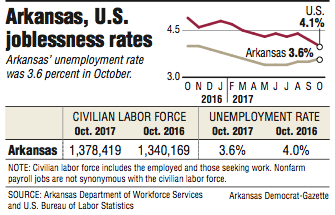Arkansas' unemployment rate rose slightly to 3.6 percent in October from 3.5 percent in September, the U.S. Bureau of Labor Statistics said Friday.
The national unemployment rate was 4.1 percent in October.
Arkansas' unemployment rate has come in at 3.4 percent or 3.5 percent since April.
Friday's report was mixed, said Michael Pakko, chief economist at the Arkansas Economic Development Institute at the University of Arkansas at Little Rock.
"The unemployment-rate side of things looks a little weak, but the [nonfarm] payroll employment side looks a little better," Pakko said.
The state's labor force fell by about 1,200, and the number of employed Arkansans dropped by about 1,900 in October compared with September. Numbers in both categories were up significantly since October 2016.
At the same time, the number of nonfarm payroll jobs grew by 23,500 since October of last year.
Arkansas' 1.9 percent growth in nonfarm payroll jobs for the past 12 months compares well with other states, Pakko said.
"That ranks about 10th or 11th in percentage change of the 50 states," Pakko said. "So payroll employment growth looks pretty healthy."
Pakko expects the state's unemployment rate to remain in the 3.5 percent to 4 percent range for the next year or so.
"I expect it to creep up near 4 percent but don't expect any big move," Pakko said.
Arkansas' labor force participation rate is not faring as well as other indicators, said Mervin Jebaraj, interim director of the Center for Business and Economic Research at the University of Arkansas, Fayetteville.
The labor force participation rate -- the percentage of people aged 16 to 64 who are working or seeking work -- was 59.1 percent in October, Jebaraj said.
Most states have labor force participation rates in the "60 percent-plus range," Jebaraj said. Arkansas' rate "has not improved a whole lot yet."
Alan Krueger, a Stanford University researcher, recently released information that helps explain why the country's labor force participation rate remains relatively low, Jebaraj said.
"He has connected some of the biggest declines in labor force participation rate to the highest amount of opioid prescriptions," Jebaraj said. "If you consider health issues that have been with us as a country and state -- obesity, diabetes -- and combine that with a lot of physical work -- pushing, pulling, shoving, lifting -- it causes pain. And the preferred pain medicine in the U.S. has been pills. That could be what is contributing to a labor force participation rate decline."
Some individuals can't do the same level of physical labor as they've done in the past, Jebaraj said.
Krueger has mapped county-by-county high rates of opioid use with a low labor force participation rate throughout the country, Jebaraj said.
"It tracks pretty well," Jebaraj said.
The comparison is obvious in some Arkansas counties, too, he said.
Arkansas had growth in seven job sectors and declines in four sectors over the past year.
The goods-producing sector of the economy, including manufacturing and construction, seems to be doing well, Pakko said.
Manufacturing had the biggest job gain, adding 5,700 in the past year. Construction has added 2,000 jobs since October 2016.
Since the end of the recession in June 2009, Arkansas had above-average growth in the professional and business-services sector, which includes professional, scientific and technical jobs, said Greg Kaza, executive director of the Arkansas Policy Foundation in Little Rock.
The sector grew 33 percent in more than eight years, adding 36,600 jobs over the period, Kaza said.
The trade, transportation and utilities sector -- which includes retail and wholesale trade and warehousing -- also had notable growth, going from 234,900 jobs in June 2009 to 258,200 jobs last month, Kaza said.
But the financial activities sector -- which includes finance, insurance, real estate and rental jobs -- has remained flat for the past eight years with only 100 more jobs last month than in June 2009, Kaza said.
Stephanie Shine, director of permanent placement services for Robert Half Finance and Accounting in Little Rock, said November is one of the busiest months of the year in the employment sector.
Shine recruits job candidates in finance and accounting, from bookkeepers to chief financial officers. The company also recruits temporary and clerical workers in accounting and finance.
Employers who are hiring need to make their decisions quickly, Shine said.
Shine told of one job candidate who interviewed this week with an investment firm. The candidate was supposed to hear back from the investment firm on Friday. But the prospect interviewed with a public accounting firm on Wednesday and accepted an offer on Thursday, Shine said.
"These candidates can be gone in less than a week if they have the right skill sets," she said.
U.S. Bureau of Labor Statistics said Hawaii had the lowest unemployment rate in the country in October at 2.2 percent, followed by North Dakota at 2.5 percent, Colorado and Nebraska both at 2.7 percent, and Idaho and Vermont both at 2.9 percent.
Alaska had the highest rate at 7.2 percent, followed by New Mexico at 6.1 percent, West Virginia at 5.1 percent and Kentucky and Nevada both at 5.0 percent.
A Section on 11/18/2017
